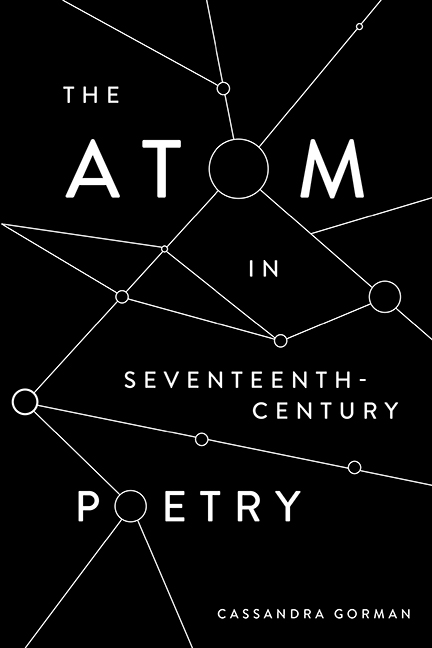Book contents
- Frontmatter
- Dedication
- Contents
- Acknowledgements
- Conventions and Abbreviations
- Introduction
- 1 Atomic Congruity: The Philosophical Poetry of Henry More
- 2 Thomas Traherne’s Atoms, Souls and Poems
- 3 World-Making and World-Breaking: The Atom Poems of Margaret Cavendish and Hester Pulter
- 4 The Atom in Genesis: Lucy Hutchinson’s Order and Disorder
- Afterword: A Poetics of the Atom
- Bibliography
- Index
- Studies in Renaissance Literature
3 - World-Making and World-Breaking: The Atom Poems of Margaret Cavendish and Hester Pulter
Published online by Cambridge University Press: 16 July 2022
- Frontmatter
- Dedication
- Contents
- Acknowledgements
- Conventions and Abbreviations
- Introduction
- 1 Atomic Congruity: The Philosophical Poetry of Henry More
- 2 Thomas Traherne’s Atoms, Souls and Poems
- 3 World-Making and World-Breaking: The Atom Poems of Margaret Cavendish and Hester Pulter
- 4 The Atom in Genesis: Lucy Hutchinson’s Order and Disorder
- Afterword: A Poetics of the Atom
- Bibliography
- Index
- Studies in Renaissance Literature
Summary
… by other atoms thrust and hurled We give a being to another world. Hester Pulter, Poem 58
Small atoms of themselves a world may make … Margaret Cavendish, ‘A World Made by Atoms’
Although the contemporaries Margaret Cavendish and Hester Pulter might seem to share general affinities – they were both female, poets and Royalist aristocrats – a comparison of their lives and works finds significant differences. While the writings of ‘Margaret the First’ have long since graced library shelves – including the collections to which she personally bequeathed copies in the 1660s – it seems unlikely that Pulter ever intended her ‘Fancies’ to see print. In contrast to Cavendish's loud self-fashioning through incessant publication and autobiographical statement, Pulter appears to have lived rather reclusively, raising fifteen children from the family seat in Hertfordshire and compiling some 120 poems, highly devotional in content, into a private manuscript over the course of twenty years. Her poems, an assortment of meditations on miscellaneous subjects, are addressed to the select audience of herself, her daughters and God – a figure that, incidentally, the natural philosopher Cavendish rarely mentions.
Yet, despite their differences in literary intent and ambition, the writers have a notable common interest: they both wrote poems about atoms. Cavendish and Pulter discovered imaginative potential in the atom and employed poetry as the medium for teasing out its productive paradoxes. In their writings, the ‘atom poem’ materialised as a recognisable form: it could stand alone or contribute to a general theme, building with other poems in sequence; it experimented with the making and unmaking of different things; explored hypotheses; contracted different ideas, relationships or experiences into one unit, or potentially ‘indivisible’ point. Their poems merged with the atom in ways that were both mechanical and thematic. Not merely the contents but also the structures of their verses were held together by the fundamental principles of atomic generation and corruption, resting on the paradox that entities so close to nothingness may ‘a new world create’.
It is the creation of worlds – their making, breaking and renewing – that emerges as the most prominent, significant focus of all Pulter and Cavendish's atom poems. New worlds promised and created through writing are promised and as good as made by atoms, which underlie every creative act, including the material letters of the text itself and the fate of the respective authors.
- Type
- Chapter
- Information
- The Atom in Seventeenth-Century Literature , pp. 117 - 174Publisher: Boydell & BrewerPrint publication year: 2021

